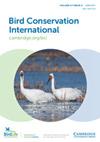利用过去和现在的基线为极度濒危的马努美阿或牙嘴鸽(Didunculus strigirostris)建立栖息地适宜性模型
IF 1.5
4区 环境科学与生态学
Q3 BIODIVERSITY CONSERVATION
引用次数: 0
摘要
摘要 以证据为基础的保护工作可能会因实地数据有限而受到阻碍,但历史档案有可能为保护相关参数提供独特的见解,例如为受威胁物种确定合适的栖息地。萨摩亚的马努美阿或牙嘴鸽(Didunculus strigirostris)数量已经减少,只有极少数残余种群仍然存在,因此保护的关键第一步是找到幸存的鸟类。我们利用历史和现代记录生成了一系列物种分布模型,以预测萨摩亚境内适宜栖息地的分布情况,从而为新的实地考察提供指导。马奴米亚的分布与森林覆盖率或其替代物密切相关。马奴米亚的首选食物植物被认为是低海拔树木,但在大多数模型中,海拔所占比例相对较低,因此不排除马奴米亚可能出现在高海拔地区。在过去的一个世纪中,也几乎没有证据表明记录中的海拔发生了变化。基于视觉记录和声学记录的模型在预测的栖息地适宜性方面存在差异,这表明一些所谓的声学记录实际上可能并不代表马努美亚的叫声。实地搜索应针对所有模型中栖息地适宜性较高的地区,尤其是乌波卢岛的森林中轴线。本文章由计算机程序翻译,如有差异,请以英文原文为准。
Modelling habitat suitability for the Critically Endangered Manumea or Tooth-billed Pigeon Didunculus strigirostris using past and present baselines
Summary Evidence-based conservation can be hindered by limited field data, but historical archives have the potential to provide unique insights into conservation-relevant parameters, such as identification of suitable habitat for threatened species. The Manumea or Tooth-billed Pigeon Didunculus strigirostris has declined on Samoa and only a tiny remnant population still persists, and a key first step for conservation is to locate surviving birds. Numerous Manumea records are available from the nineteenth century onwards, and we used historical and modern records to generate a series of species distribution models to predict the distribution of suitable habitat across Samoa to guide new field searches. Manumea distribution is closely associated with forest cover or its proxies. Preferred Manumea food plants are suggested to be low-elevation trees, but elevation provides relatively low percentage contribution in most models, thus not excluding the possibility that Manumea might occur at high elevations. There is also little evidence for elevational change in records over the past century. Models based on visual versus acoustic records exhibit differences in predicted habitat suitability, suggesting that some purported acoustic records might not actually represent Manumea calls. Field searches should target areas representing high habitat suitability across all models, notably the forested central axis of Upolu.
求助全文
通过发布文献求助,成功后即可免费获取论文全文。
去求助
来源期刊
CiteScore
3.40
自引率
6.20%
发文量
50
审稿时长
>12 weeks
期刊介绍:
Bird Conservation International is a quarterly peer-reviewed journal that seeks to promote worldwide research and action for the conservation of birds and the habitats upon which they depend. The official journal of BirdLife International, it provides stimulating, international and up-to-date coverage of a broad range of conservation topics, using birds to illuminate wider issues of biodiversity, conservation and sustainable resource use. It publishes original papers and reviews, including targeted articles and recommendations by leading experts.

 求助内容:
求助内容: 应助结果提醒方式:
应助结果提醒方式:


